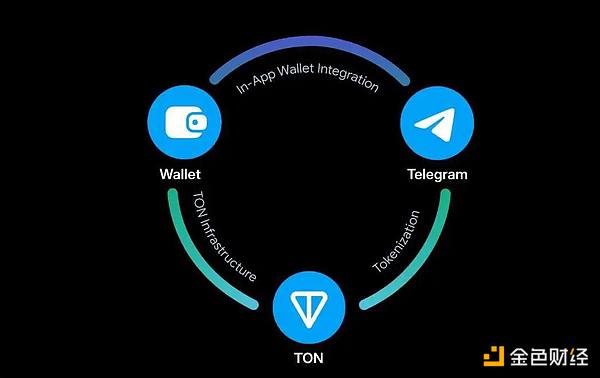Web3 Social Resurgence Who will be the next phenomenon-level application among friend.tech, Telegram, and others?
Web3 Social Resurgence The next phenomenon-level application - friend.tech, Telegram, or others?Author: Terry | Plain Language Blockchain

Web3 social networking has always been a topic of discussion. Recently, the hot new player in Web3 social networking, friend.tech, has sparked a wave of excitement in the crypto community with its social viral and IP monetization strategies, bringing the concept of Web3 social networking back into the spotlight.
In fact, up to now, the development of the entire Web3 social networking track is still in its early stages. The definition of Web3 social networking in the crypto industry has been inconsistent, with no unified opinion:
- Tether CTO reveals the truth about stablecoin reserves
- Vitalik’s New Article Explained in Detail Why ‘Adding Off-Protocol Functionality’ Is an Extremely Important Consideration Factor
- Rollup 2.0 The Battle of Decentralized Sorters
On the one hand, projects labeled as “Web3 social networking” have emerged one after another, including content platforms, social platforms, instant messaging, and other single-application projects, as well as infrastructure protocols such as social media protocols, asset data protocols, and decentralized social graphs, which are overwhelming;
On the other hand, none of the projects that hope to depict a feasible vision and future of Web3 social networking have presented convincing enough products. The exploration of “Web3 social networking” by various parties is still a blind man’s touch of an elephant.
01 Mainstream Web3 Social Networking Protocols
Currently, the “application layer” exploration of Web3 social networking can mainly be divided into content platforms, social platforms, instant messaging, social tools, and other tracks. Let’s observe some typical mainstream projects in these areas.
-
friend.tech: The Rising Star of Web3 Social Networking
The model of friend.tech is to tokenize individuals’ social influence. Fans or other users can purchase shares of KOLs and have the opportunity to chat privately with them. At the same time, the value of the shares will increase as more people buy them, creating profit opportunities for the holders.
The advantages of friend.tech lie in its good user experience and “quasi-Ponzi scheme” gameplay. The former is reflected in some details, such as new users only needing to log in with their Google or Apple accounts, recharge the automatically generated wallet, and friend.tech has recently launched a web version, allowing users to use it in a browser.
The latter is more crucial. Once this quasi-Ponzi scheme starts, it is indeed easy to gain momentum and trigger FOMO emotions:
Early investors have an advantage and can also incentivize new users to join quickly and purchase KOL shares. As the participation increases, the share price will rise, and early participants will be motivated to actively promote the platform, thereby helping to increase the user base of the platform.
-
Lens Protocol: “Web3-ized Twitter”
The vision of Lens Protocol is like a “Web3-ized Twitter” – mainly based on new content created by users (posts, images, music, etc.), all social activities of an individual address (posts, follows, comments, mirrors, etc.) are recorded and minted as NFTs to establish ownership through content NFTization.
In addition, Lens Protocol has considered modularity from the beginning, positioning itself as a universal protocol that can be used as middleware to support the integration of any platform. Any project that wants to build a Web3 social network can use Lens Protocol’s social graph and build products based on unified underlying standards.
Simply put, Lens Protocol is a Web3 social relationship graph built on the blockchain, which focuses on “social connections with acquaintances” with social media functionality (similar to Twitter and Weibo) and combines fan economy. It uses NFT to authenticate content creation and social interactions, ultimately forming a social graph:
Specifically, Lens focuses on enabling creators to have social interactions with their communities (such as posting, following, collecting, and reposting), allowing creators to establish connections with their communities. It creates individual social graphs centered around creators.
-
CyberConnect: A developer-oriented social graph protocol
CyberConnect is a decentralized social graph protocol built in Web3. The social graph data it encompasses includes not only wallet addresses, relevant assets, and on-chain transaction activities, but also off-chain data and connection data from social networking sites such as Twitter. It also includes wallet lists of followers and those being followed.
Therefore, CyberConnect primarily provides infrastructure integration services for developers of different applications, allowing these applications to efficiently and quickly adopt CyberConnect’s social graph data, or to provide targeted services for addresses with specific characteristics.
On the other hand, as the number and variety of applications accessing CyberConnect’s infrastructure increase (including games, metaverses, NFT markets, content publishing, media, and social applications), users can “roam” across multiple DApps with their asset data, identities, and social graph relationships.
-
BBS Network: Decentralized forum
If friend.tech and Lens are products similar to Twitter, then BBS Network is a “Web3 version” of a public message board (forum), similar to Tieba and Reddit:
It consists of countless potential forums, where users can freely create forums, determine their themes, and manage operations. Users can also initiate or participate in any discussions, exchange ideas, and create content.
Overall, BBS Network has four roles: Developer, Operator, BBS Owner, and User:
– Developers can build front-ends that better suit user experiences based on underlying data;
– Operators provide data storage services;
– Forum owners can create forums (any user can create their own forum through BBS.market);
– Users create content and react to content.
BBS Network stores all data on the blockchain, with each post being turned into an NFT that can be bought, sold, and collected by users. This way, the ownership of content is returned to the creators in the form of NFTs, updating the traditional application revenue model.
In general, the content mechanisms of platforms like friend.tech and Lens are essentially no different from traditional content platforms. They mainly incorporate the Token model:
On the one hand, they directly convert the influence and creativity of creators on social media into a cash flow income;
On the other hand, they remove the constraints of traditional internet “intermediary platforms”, allowing creators to not need to go through any centralized platform or be restricted or “exploited” by any centralized platform (although platforms like friend.tech also charge fees).
02 Telegram’s New Attempt
Compared to the aforementioned Web3 native social projects, Telegram can be seen as an attempt in the opposite direction.
The blockchain world has always lacked real incremental users, which is a recognized pain point and difficulty. Apart from the leading CEX/DEX, even Web3 projects like Brave, which have millions of daily active users, may pale in comparison to Telegram, the world’s largest encrypted communication software with hundreds of millions of active users.
And the aforementioned Lens, CyberConnect, and other Web3 social projects are naturally not in the same league. This broad user base and sufficient openness are Telegram’s biggest competitive advantages compared to many native Web3 projects.
At the same time, since the launch of the TON Token financing plan in 2018, Telegram has been getting closer to encrypted projects and blockchain.
Especially recently, Telegram has been trying to complete a three-step jump from communication protocol to social platform, and ultimately become a super app based on its extensive user base.
For example, the recent Telegram bots have created a separate track, with various new projects and copycats emerging. Among them, the TON Foundation launched the Telegram Apps application center in August this year, integrating various applications from games and wallets to utility tools within Telegram.
Thanks to the open-source nature of the Telegram client, various rich SDKs, and the comprehensive Bot API provided by the official team for developers, countless developers can create various service bots on their own and openly compete with official applications. Users can easily find various service functions such as music, movies, books, and games on Telegram.

Steve Yun, Chairman of the TON Foundation, and John Hyman, Chief Information Officer of Telegram, also gave a speech titled “Transforming Telegram into Web3 with Toncoin” at TOKEN2049, stating that the goal is to integrate TON into existing Telegram applications and encourage projects to use small applications as the user layer to expand influence and adoption.
03 Where will Web3 Social Breakthrough?
In fact, returning to the root, the essence of social interaction is the manifestation of personal value. With the support of blockchain, this value can be visually represented in the form of money (Token) – users can monetize their social influence and directly obtain income in the form of Tokens, without the problem of platforms or third parties taking a cut.
This is also one of the core reasons why NFT has a deep connection with Web3 social media. With the unique characteristics of NFT, it is possible to map unique creative content onto the blockchain, using NFT as the underlying carrier for Web3 social interactions.
Just like Lens mentioned earlier, it records and mintes all social activities (posts, follows, comments, mirrors, etc.) of an individual address as NFTs. By tokenizing content through NFTs, Lens ensures ownership and the composability and decentralization of its features all revolve around NFT attributes.
The underlying protocol can charge fees for each tweet as an NFT, allowing creators to directly profit from views and shares, effectively tokenizing tips from content creators or user payments.
So when Musk acquired Twitter, many people were expecting him to use Dogecoin or other cryptocurrencies to achieve the Web3 transformation of the platform.
However, the “financialization of social media” has not yet been widely adopted due to various reasons, including the challenge of balancing decentralization and user experience, limitations in user base and scale, and a lack of innovative gameplay.
From this perspective, Telegram is currently one of the most promising directions for breakthroughs. The social scenarios between accounts in Telegram can fundamentally integrate financial functions, and Telegram is indeed taking steps in this direction:
– Unibot introduces stablecoin exchange functions, allowing users to use the standard buy and sell options in the main menu for this feature;
– Launching self-custodial wallets on Telegram;
– EthSign collaborates with TON to introduce the EthSign bot, enabling contract signing within Telegram;
– The encrypted payment solution Wallet LianGuaiy supports Bitcoin, Tether, and Toncoin payments within the Telegram interface;
– TON introduces encrypted messaging with end-to-end encryption, ensuring only the sender and receiver can see the message content.
This also means socializing all financial scenarios (transfers, transactions, payments, etc.) and implementing social+financial functions such as transfers, fund flows, and asset custody, combined with a user base of 800 million, creating immense possibilities.
This is also the future direction with great imagination in Web3 social interactions – automating and tokenizing payment, rewards, and transaction settlement modules at the underlying protocol level, creating a completely new Web3 social landscape.
END
We will continue to update Blocking; if you have any questions or suggestions, please contact us!
Was this article helpful?
93 out of 132 found this helpful
Related articles
- Looking ahead Lightning Payment in 2025
- Security Monthly Report | Stay Vigilant! The total losses caused by hacker attacks and other factors in the Web3 ecosystem in September exceeded $360 million!
- An analysis of three concepts related to Lagrange products State Proof, Lagrange Committee, and ZK Big Data.
- From the discussion of the Friend.Tech fork, what other use cases does SocialFi have?
- Playing with deception Overseas version of ‘Miao Ya’ BeFake goes viral worldwide
- Anthropic, which has seen a skyrocketing valuation, has become FTX’s biggest hope for debt repayment.
- StepN Founder Jerry What are the considerations for Web3 game creators?





